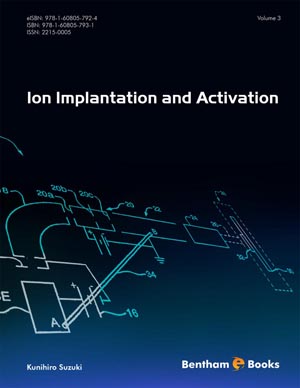Book Volume 3
Diffusion Under Thermal Equilibrium
Page: 3-34 (32)
Author: Kunihiro Suzuki
DOI: 10.2174/9781608057924113030003
PDF Price: $15
Abstract
We derive a diffusion flux and diffusion equation step by step, starting with a rough sketch one to a practical one. The flux is described with the paring with point defects, and the dependence of diffusion coefficients on doping concentration is emerged. We can predict diffusion profiles by solving the equation.
Paring Diffusion Equation
Page: 35-55 (21)
Author: Kunihiro Suzuki
DOI: 10.2174/9781608057924113030004
PDF Price: $15
Abstract
In this section, we consider reaction between impurity, point defects, and charges in diffusion phenomenon and diffusion equations for both of impurity and point defects. There are many levels of sophistication of treatment of the interaction of impurity and point defects. We perform approximations step by step, and derive diffusion models in various supplication levels.
Experimental Data Associated with Transient Diffusion
Page: 56-82 (27)
Author: Kunihiro Suzuki
DOI: 10.2174/9781608057924113030005
PDF Price: $15
Abstract
We should determine various ambiguous physical parameters of the transient diffusion (TED) models associated with paring to understand TED fully. On the other hand, we can only obtain total impurity concentration profile data which lack paring information. We should guess the paring parameters from total redistributed impurity concentration profiles. The difficulty that fundamental data can only be evaluated at low-temperature regions also exist, that is, we cannot simply relate the profiles to a target temperature set at practical temperatures of about 1000°C. This means that the TED starts and ends in the ramping process at the target temperature. Therefore, we show TED data at low temperatures, and clarify its prominent features. The characteristics at high temperatures can be evaluated by extrapolating the parameter values.
Simple Treatment of Transient Enhanced Diffusion
Page: 83-100 (18)
Author: Kunihiro Suzuki
DOI: 10.2174/9781608057924113030006
PDF Price: $15
Abstract
A two-stream model which describes impurity flux and point defect flux independently has been proposed. Equation for point defect flux gives macroscopic information about the impurity flux equation, such as enhanced diffusion coefficient and time duration of TED. The model also accommodates the ramp up process where enhanced diffusion and time duration parameters become variable. This simple model can be controlled and tuned simply and gives us prominent features of TED.
Thermal Oxidation
Page: 101-119 (19)
Author: Kunihiro Suzuki
DOI: 10.2174/9781608057924113030007
PDF Price: $15
Abstract
Oxidation model is derived by considering diffusion fluxes in gas phase atmosphere, growing oxide layer, and reaction of oxidant and substrate Si atoms at SiO2/Si interface. This model gives simple time dependence of growing SiO2 layer thickness. The impurities in the Si substrate redistribute during the oxidation. We treat the redistributed profile as moving boundary one, and derive the corresponding model. The model well predicts B depletion at the SiO2/Si interface.
Segregation
Page: 120-127 (8)
Author: Kunihiro Suzuki
DOI: 10.2174/9781608057924113030008
PDF Price: $15
Abstract
Segregation is a coefficient defined as the ratio of impurity concentrations at both sides of two different layers, which influences the diffusion profiles. However, the ratio is rarely in thermal equilibrium in general cases. Hence, the evaluation of the value of the segregation is difficult. It is found that the thermal equilibrium of segregation has been established in the redistribution profile of impurities in oxidized polycrystalline Si (polysilicon) because the diffusion coefficient is much larger than that in Si. The redistribution model is derived, and related segregation values are evaluated.
Analytical Diffusion Profiles Under Various Boundary Conditions
Page: 128-204 (77)
Author: Kunihiro Suzuki
DOI: 10.2174/9781608057924113030009
PDF Price: $15
Abstract
We can obtain analytical models for impurity diffusion profiles in some specific cases, although it is difficult to solve this in general. We first show various analytical models assuming constant diffusion coefficients, and then present the models with variable diffusion coefficients. We further display analytical models for two-dimensional diffusion profiles, and profiles for multi-layers.
Introduction
Ion Implantation and Activation presents the derivation process of related models in a comprehensive step by step manner starting from the fundamental processes and moving up into the more advanced theories. Ion implantation can be expressed theoretically as a binary collision, and, experimentally using various mathematical functions. Readers can understand how to establish an ion implantation database by combining theory and experimental data. The models described in this ebook can be directly related to practical experimental data with various approaches: physical, empirical or experimental. Readers can also understand the approximations, and assumptions to reach these models. The redistribution and activation of implanted impurities during subsequent thermal processes are also important subjects and they are described in a broad manner with the combination of theory and experiment, even though many of the models are not well established. Chapters in the book explain, in depth, various topics such as Pearson functions, LSS theory, Monte Carlo simulations, Edgeworth Polynomials and much more. This book provides advanced engineering and physics students and researchers with complete and coherent coverage of modern semiconductor process modeling. Readers can also benefit from this volume by acquiring the necessary information to improve contemporary process models by themselves.




















